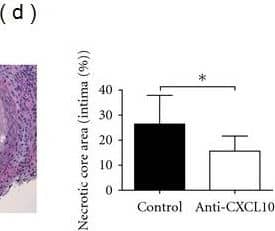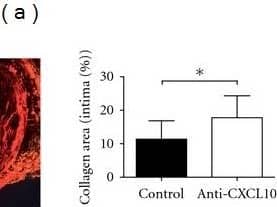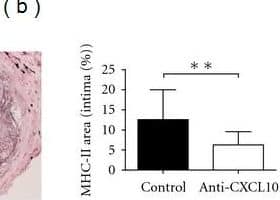Mouse CXCL10/IP-10/CRG-2 Antibody Best Seller
R&D Systems, part of Bio-Techne | Catalog # MAB466

Key Product Details
Species Reactivity
Validated:
Cited:
Applications
Validated:
Cited:
Label
Antibody Source
Product Specifications
Immunogen
Ile22-Pro98
Accession # P17515
Specificity
Clonality
Host
Isotype
Endotoxin Level
Scientific Data Images for Mouse CXCL10/IP-10/CRG-2 Antibody
Chemotaxis Induced by CXCL10/CRG-2 and Neutralization by Mouse CXCL10/CRG-2 Antibody.
Recombinant Mouse CXCL10/CRG-2 (Catalog # 466-CR) chemoattracts the BaF3 mouse pro-B cell line transfected with human CXCR3 in a dose-dependent manner (orange line). The amount of cells that migrated through to the lower chemotaxis chamber was measured by Resazurin (Catalog # AR002). Chemotaxis elicited by Recombinant Mouse CXCL10/CRG-2 (0.5 µg/mL) is neutralized (green line) by increasing concentrations of Mouse CXCL10/CRG-2 Monoclonal Antibody (Catalog # MAB466). The ND50 is typically 10-40 µg/mL.Detection of Mouse CXCL10/IP-10/CRG-2 by Immunohistochemistry
Anti-CXCL10 treatment in atherosclerosis susceptible mice results in a change into a more stable lesion phenotype. A flow-altering device around the common carotid artery induced atherosclerosis in ApoE−/− mice. From week 1 to 4 of lesion development, a bioactivity-neutralizing anti-CXCL10 antibody was injected. After 9 weeks, lesions were compared to untreated controls by histology. The pictures show representative histological sections of treated and control mice. All photographs have been made with the same magnification (100x). Scale bars are provided in (e) and represent 100 μm. Data in bar diagrams are the mean values ± SD of at least 8 sections from at least 10 different animals per group. CXCL10 inhibition resulted in a more stable morphology evidenced by unchanged amounts of lesion macrophages (a), increased amounts of collagen (b), decreased macrophage activation (c), increased numbers of SMC (d), and reduced necrotic core size (e). *P < 0.05, **P < 0.01. MHC-II: Major Histocompatibility Complex Class II, SMC: smooth muscle cell. Image collected and cropped by CiteAb from the following open publication (https://pubmed.ncbi.nlm.nih.gov/22164344), licensed under a CC-BY license. Not internally tested by R&D Systems.Detection of Mouse CXCL10/IP-10/CRG-2 by Immunohistochemistry
Anti-CXCL10 treatment in atherosclerosis susceptible mice results in a change into a more stable lesion phenotype. A flow-altering device around the common carotid artery induced atherosclerosis in ApoE−/− mice. From week 1 to 4 of lesion development, a bioactivity-neutralizing anti-CXCL10 antibody was injected. After 9 weeks, lesions were compared to untreated controls by histology. The pictures show representative histological sections of treated and control mice. All photographs have been made with the same magnification (100x). Scale bars are provided in (e) and represent 100 μm. Data in bar diagrams are the mean values ± SD of at least 8 sections from at least 10 different animals per group. CXCL10 inhibition resulted in a more stable morphology evidenced by unchanged amounts of lesion macrophages (a), increased amounts of collagen (b), decreased macrophage activation (c), increased numbers of SMC (d), and reduced necrotic core size (e). *P < 0.05, **P < 0.01. MHC-II: Major Histocompatibility Complex Class II, SMC: smooth muscle cell. Image collected and cropped by CiteAb from the following open publication (https://pubmed.ncbi.nlm.nih.gov/22164344), licensed under a CC-BY license. Not internally tested by R&D Systems.Applications for Mouse CXCL10/IP-10/CRG-2 Antibody
Western Blot
Sample: Recombinant Mouse CXCL10/IP-10/CRG-2 (Catalog # 466-CR)
Neutralization
Mouse CXCL10/IP-10/CRG-2 Sandwich Immunoassay
Reviewed Applications
Read 1 review rated 5 using MAB466 in the following applications:
Formulation, Preparation, and Storage
Purification
Reconstitution
Formulation
Shipping
Stability & Storage
- 12 months from date of receipt, -20 to -70 °C as supplied.
- 1 month, 2 to 8 °C under sterile conditions after reconstitution.
- 6 months, -20 to -70 °C under sterile conditions after reconstitution.
Background: CXCL10/IP-10/CRG-2
The gene for CRG-2, a mouse homolog of human IP-10, was originally identified as an immediate early gene induced in response to macrophage activation. It has since been shown that CRG-2 mRNA is induced by alpha/ beta/ gamma-interferons and by lipopolysaccharide in macrophages, astrocytes and microglia. Human IP-10 was also shown to be expressed in activated T-lymphocytes, splenocytes, keratinocytes, osteoblasts, astrocytes, and smooth muscle cells. Mouse CRG-2 cDNA encodes a 98 amino acid (aa) residue precursor protein with a 21 aa residue signal peptide that is cleaved to form the 77 aa residue secreted mature protein. Mature CRG-2 shares approximately 67% amino acid sequence identity with human IP-10. The amino acid sequence of CRG-2 identified the protein as a member of the chemokine alpha subfamily that lacks the ELR domain. CRG-2 has been shown to be a chemoattractant for activated T-lymphocytes. Recently, human IP-10 has also been reported to be a potent inhibitor of angiogenesis and to display a potent thymus-dependent anti-tumor effect. A chemokine receptor specific for IP-10 and MIG (CXCR3) has been cloned and shown to be highly expressed in IL-2-activated T-lymphocytes.
References
- Loetscher, M. et al. (1996) J. Exp. Med. 184:963.
- Vanguri, P. (1996) J. Neuroimmunol. 56:35.
- Sgadari, C. et al. (1996) Blood, 87:3877.
Alternate Names
Gene Symbol
UniProt
Additional CXCL10/IP-10/CRG-2 Products
Product Documents for Mouse CXCL10/IP-10/CRG-2 Antibody
Product Specific Notices for Mouse CXCL10/IP-10/CRG-2 Antibody
For research use only



